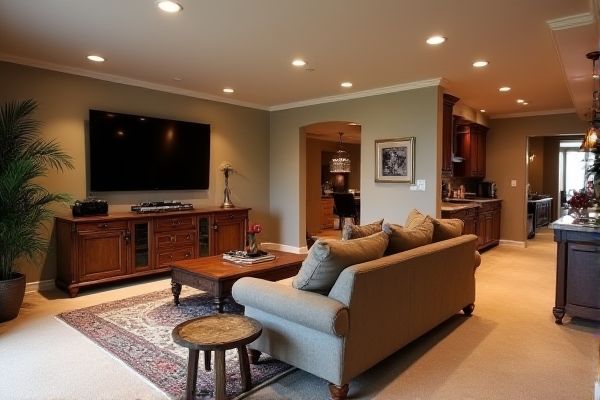
Traditional basement furniture features classic designs with ornate details and rich wood finishes, creating a warm, timeless atmosphere. Contemporary furniture offers sleek lines, minimalistic styles, and modern materials that maximize space and functionality; discover how each style can transform Your basement by reading the rest of the article.
Table of Comparison
| Feature | Traditional Basement Furniture | Contemporary Basement Furniture |
|---|---|---|
| Design Style | Classic, ornate, heavy wood | Minimalist, clean lines, sleek |
| Materials | Solid wood, leather, fabric upholstery | Metal, glass, engineered wood, synthetic fabrics |
| Color Palette | Warm tones, rich hues | Neutral colors, monochrome, bold accents |
| Functionality | Static, decorative | Multi-functional, space-saving |
| Comfort | Plush, cushioned seating | Ergonomic designs, adjustable |
| Durability | Long-lasting, heavy build | Lightweight but sturdy |
| Technology Integration | Minimal or none | Smart furniture, built-in charging ports |
Introduction to Basement Furniture Styles
Traditional basement furniture emphasizes classic design elements such as ornate woodwork, rich fabrics, and warm color palettes, creating a cozy and timeless atmosphere. Contemporary basement furniture features clean lines, minimalist forms, and neutral tones that promote a sleek, modern, and functional space. Understanding these styles helps homeowners select pieces that complement their basement's purpose and architectural features.
Defining Traditional Basement Furniture
Traditional basement furniture features classic designs characterized by ornate details, rich wood finishes, and timeless silhouettes inspired by historical periods such as Victorian or Colonial styles. This furniture typically emphasizes comfort and elegance through tufted upholstery, carved legs, and warm, deep color palettes that create a cozy, inviting atmosphere. Your choice of traditional basement furniture reflects a preference for enduring craftsmanship and a nostalgic aesthetic that contrasts with the sleek lines and minimalist forms of contemporary pieces.
Features of Contemporary Basement Furniture
Contemporary basement furniture is characterized by clean lines, minimalist design, and multifunctional pieces that maximize space efficiency. Materials like metal, glass, and engineered wood are commonly used to create a sleek, modern aesthetic that complements open floor plans. Features often include modular seating, built-in storage solutions, and neutral or bold color palettes that enhance the overall functionality and style of basement living areas.
Material Choices: Classic vs Modern
Traditional basement furniture often features rich hardwoods like oak, cherry, and mahogany, paired with upholstered fabrics such as velvet and leather that emphasize warmth and durability. Contemporary designs favor sleek materials like metal, glass, and engineered wood, combined with minimalist upholstery options such as faux leather and performance fabrics that highlight functionality and easy maintenance. Your choice between classic and modern material options impacts the basement's ambiance, balancing timeless elegance with streamlined practicality.
Color Schemes: Warmth versus Minimalism
Traditional basement furniture often features warm color schemes with rich browns, deep reds, and earthy tones that create a cozy, inviting atmosphere. Contemporary basement designs favor minimalism, utilizing neutral palettes such as whites, grays, and blacks to enhance space perception and foster a clean, modern look. Your choice between these styles influences the basement's overall mood, balancing warmth with simplicity to suit your personal aesthetic preferences.
Functionality and Space Optimization
Traditional basement furniture often emphasizes elaborate designs and heavy materials, which can limit space optimization and multifunctional use. Contemporary basement furniture prioritizes sleek, lightweight designs that maximize functionality by incorporating storage solutions and modular components ideal for small or irregularly shaped spaces. Space optimization techniques in contemporary furniture include foldable tables, built-in shelving, and convertible seating, enhancing usability without sacrificing style.
Comfort and Ergonomics: Old Meets New
Traditional basement furniture often emphasizes rich textures and ornate designs, providing a timeless sense of comfort but sometimes lacks modern ergonomic support. Contemporary pieces prioritize adjustable features and materials designed to enhance posture and reduce strain, aligning with today's focus on wellness. You can blend both styles to create a basement space that offers classic aesthetics alongside advanced comfort and ergonomic benefits.
Cost Comparison: Tradition vs Innovation
Traditional basement furniture often entails higher costs due to handcrafted details and classic materials like solid wood, while contemporary pieces typically offer budget-friendly options with modular designs and synthetic materials. You can save significantly by choosing innovative furniture that emphasizes functionality and minimalism without compromising style. Investing in contemporary furniture aligns with modern trends and practical use, making it a cost-effective choice for updating your basement space.
Popular Trends in Basement Furnishing
Traditional basement furniture emphasizes classic wood finishes, ornate detailing, and tufted upholstery, creating a warm, timeless ambiance. Contemporary basement furnishing trends highlight sleek lines, minimalist designs, and multifunctional pieces made from metal, glass, and engineered wood to maximize space and functionality. Popular items include modular sofas, industrial-style shelving, and built-in storage solutions that cater to modern lifestyle needs while enhancing aesthetic appeal.
Choosing the Right Style for Your Basement
Choosing the right style for your basement involves balancing function and aesthetics to suit the space's purpose and your personal taste. Traditional basement furniture often features rich wood tones, classic silhouettes, and ornate details, ideal for creating a cozy, timeless ambiance. In contrast, contemporary furniture emphasizes clean lines, neutral colors, and minimalist designs, perfect for maximizing space and fostering a modern, open feel.
 homyna.com
homyna.com